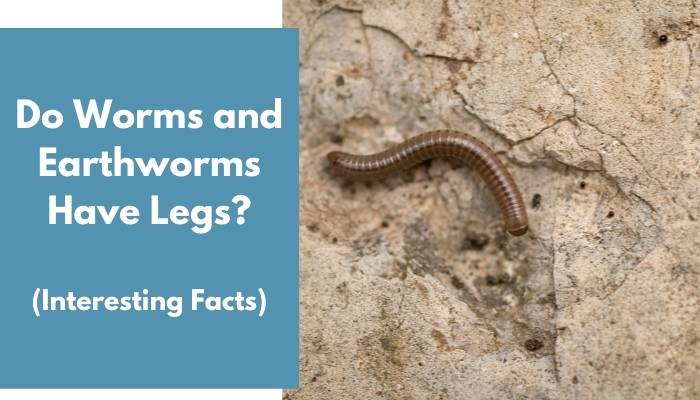It’s quite evident that worms aren’t attractive animals, unlike the ones we take home as pets. In fact, many even associate them with dirtiness and such stuff. Still, worms remain to be beneficial in many ways, and they are fascinating.
For instance, a curious mind would wonder about their movements. Since they are nothing but long and jiggly bodies, you may wonder if they even have legs. Thus, you may ask:
Do worms and earthworms have legs? No, worms and earthworms have no legs. In fact, they don’t even have arms, bones, and even eyes. Instead, they have a set of setae, tiny bristles used as tools to help them grip the soil as they move. They navigate around using two different groups of muscles.
Since worms have no legs, it is interesting to know how they move without such. This article will have a deep dive into the worms’ movements and how they burrow without legs.
Let’s get into it!
Contents
How many legs does a worm have?
As I said earlier, worms have no legs. So, you may ask how they move around.
In the first place, worms crawl instead of walk. Thus, in essence, they won’t need a pair of legs or more to do so.
Worms crawl through a certain way. First, their body has a design that suits underground life.
The body of a worm has multiple segments. Each of these segments has a group of setae. The setae are a small bristle that helps the worms grip the soil, allowing them to move.
Further, earthworms move using two different sets of muscles. Since they are always underground, they don’t have any difficulty crawling.
Moreover, worms have no bones. While having none can mean less protection and more vulnerability, it helps them move.
Having no bones means the movement of worms doesn’t get any restrictions. Further, it means these animals can move freely, in any direction, without bones preventing the action.
Related Articles About Worms Anatomy:
- Do Worms and Earthworms Have Ears?
- Do Worms And Earthworms Have Lungs?
- Do Worms And Earthworms Have Blood?
- Do Worms And Earthworms Have Hearts?
Why do worms not have legs?
Worms do not have legs because it’s not suitable for them. Most invertebrates underground don’t have legs because it won’t help them crawl.
Since worms live underground, legs won’t be suitable since they aren’t walking around. Instead, they crawl all the time.
Rather than legs, they have different segments, each containing a group of setae. If you don’t know what it is, it’s tiny bristles found in invertebrates.
Such a tool helps worms grip on the soil whenever they crawl. Thus, it helps them navigate and move around without having any legs at all.
What kind of worm has legs?
If you wonder what kind of worm has legs, that would be millipedes, although they are not worms.
Millipedes are also called a myriapod invertebrate with an elongated body. Their bodies consist of many segments, just like worms.
However, unlike worms, millipedes have about two pairs of legs in each segment. Millipedes are usually herbivorous and shun the light. Thus, like worms, they live in the soil or under stones and logs.
Due to many similarities, millipedes are often called 1000-legged worms. They are wormlike, but they are different from what we consider worms.
How do worms move without legs?
Since worms don’t have any legs, they move differently than other animals.
Instead of walking, worms crawl using their body segments. Each segment has a setae group, which are tiny bristle-like tools used to grip on the soil.
With such a tool, worms can navigate through the ground without any problems. Moreover, their bodies consist of many muscles, but they use two kinds to move.
While the setae help them navigate, they have other tools such as the dark and light receptors. These receptors help them navigate through the ground and protects them as well.
For instance, the dark receptors help them identify that they are beneath the ground. It also helps them determine how close they are to the surface.
On the other hand, the light helps worms avoid going to the surface. It works as an alarm since they can’t stay under direct sunlight for too long.
The sun would dry them out in a matter of minutes, eventually leading to death.
Read also other articles about worms’ bones, mouths, eyes, heads and brains, and hair.
Summary
Worms may not be attractive, but they remain to be very beneficial and also enjoyable to study. Further, they can surprise us with many fun facts. One of these is how they can live without bones.
Worms have a unique build, unlike other animals or us. Unlike us, they have no legs to help them walk. Instead, their bodies have several segments containing a group of setae. The setae are tiny bristles that help them grip the soil where they move.
In essence, they have bodies consisting of nothing but muscles. Thus, they can be quite fragile and sensitive even to small things such as exposure to the sun and a simple dry environment.
Despite that vulnerability, worms live and thrive even without legs. For instance, since they have no legs, they crawl and grip the ground using the bristles.
For this reason, they can move freely according to whatever is necessary.
Resources
Image credits – Canva



